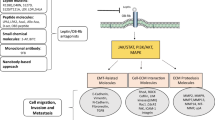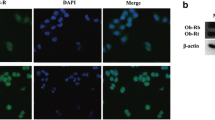Abstract
In breast tumors, high levels of leptin have been associated with increased incidence of breast cancer metastasis. Breast cancer metastasis is directly associated with breast cancer cell invasion. However, whether leptin could augment breast cancer cell invasion is not known. Here we showed that leptin increased the invasiveness and the matrix metallo-proteinase-2 (MMP-2) activity of the MCF-7 breast cancer cell line. Leptin stimulated the phosphorylation of extracellular signals regulated kinases, signal transducers and activators of transcription 3 and Jun N-terminal kinases (JNK); however, only inhibition of JNK decreased leptin-mediated activation of MMP-2. Furthermore, inhibition of JNK suppressed leptin-mediated breast cancer cell invasion. Here we report the novel findings that leptin increased invasion of breast cancer cells by activating JNK, resulting in increased MMP-2 activity.




Similar content being viewed by others
Abbreviations
- DMEM/F-12:
-
Dulbecco’s Modified Eagle’s Medium/Nutrient Mixture F-12
- ERK:
-
Extracellular signals regulated kinases
- JAK2:
-
Janus-activated kinase 2
- JNK:
-
Jun N-terminal kinases
- MMPs:
-
Metalloproteinases
- SRC:
-
Sarcoma oncogene
- STAT3:
-
Signal transducers and activators of transcription 3
References
McTiernan A (2000) Associations between energy balance and body mass index and risk of breast carcinoma in women from diverse racial and ethnic backgrounds in the U.S. Cancer 88:1248–1255. doi:10.1002/(SICI)1097-0142(20000301)88:5+<1248::AID-CNCR12>3.0.CO;2-1
Trentham-Dietz A, Newcomb PA, Egan KM et al (2000) Weight change and risk of postmenopausal breast cancer (United States). Cancer Causes Control 11:533–542. doi:10.1023/A:1008961931534
Petrelli JM, Calle EE, Rodriguez C et al (2002) Body mass index, height, and postmenopausal breast cancer mortality in a prospective cohort of US women. Cancer Causes Control 13:325–332. doi:10.1023/A:1015288615472
Morimoto LM, White E, Chen Z et al (2002) Obesity, body size, and risk of postmenopausal breast cancer: the women’s health initiative (United States). Cancer Causes Control 13:741–751. doi:10.1023/A:1020239211145
Calle EE, Rodriguez C, Walker-Thurmond K et al (2003) Overweight, obesity and mortality from cancer in a prospectively studied cohort of U.S. adults. N Engl J Med 348:1625–1638. doi:10.1056/NEJMoa021423
Porter GA, Inglis KM, Wood LA et al (2006) Effect of obesity on presentation of breast cancer. Ann Surg Oncol 13:327–332. doi:10.1245/ASO.2006.03.049
Verreault R, Brisson J, Deschenes L et al (1989) Body weight and prognostic indicators in breast cancer modifying effect of estrogen receptors. Am J Epidemiol 129:260–268
Giuffrida D, Lupo L, La Porta GA et al (1992) Relation between steroid receptor status and body weight in breast cancer patients. Eur J Cancer 28:112–115. doi:10.1016/0959-8049(92)90397-K
Huang WY, Newman B, Millikan RC (2000) Hormone-related factors and risk of breast cancer in relation to estrogen receptor and progesterone receptor status. Am J Epidemiol 151:703–714
Zhang Y, Proenca R, Maffei M et al (1994) Positional cloning of the mouse obese gene and its human homologue. Nature 372:425–432. doi:10.1038/372425a0
Sinha MK, Opentanova I, Ohannesian JP et al (1996) Evidence of free and bound leptin in human circulation. Studies in lean and obese subjects and during short-term fasting. J Clin Invest 98:1277–1282. doi:10.1172/JCI118913
McGregor GP, Desaga JF, Ehlenz K et al (1996) Radiommunological measurement of leptin in plasma of obese and diabetic human subjects. Endocrinology 137:1501–1504. doi:10.1210/en.137.4.1501
Ishikawa M, Kitayama J, Nagawa H (2004) Enhanced expression of leptin and leptin receptor (OB-R) in human breast cancer. Clin Cancer Res 10:4325–4331. doi:10.1158/1078-0432.CCR-03-0749
Miyoshi Y, Funahashi T, Tanaka S et al (2006) High expression of leptin receptor mRNA in breast cancer tissue predicts poor prognosis for patients with high, but not low, serum leptin levels. Int J Cancer 118:1414–1419. doi:10.1002/ijc.21543
Caldefie-Chezet F, Damez M, de Latour M et al (2005) Leptin: a proliferative factor for breast cancer? Study on human ductal carcinoma. Biochem Biophys Res Commun 334:737–741. doi:10.1016/j.bbrc.2005.06.077
Garofalo C, Koda M, Cascio S et al (2006) Increased expression of leptin and the leptin receptor as a marker of breast cancer progression: possible role of obesity-related stimuli. Clin Cancer Res 12:1447–1453. doi:10.1158/1078-0432.CCR-05-1913
Revillion F, Charlier M, Lhotellier V et al (2006) Messenger RNA expression of leptin and leptin receptors and their prognostic value in 322 human primary breast cancers. Clin Cancer Res 12:2088–2094. doi:10.1158/1078-0432.CCR-05-1904
Hu X, Juneja SC, Maihle NJ et al (2002) Leptin–a growth factor in normal and malignant breast cells and for normal mammary gland development. J Natl Cancer Inst 94:1704–1711
Yin N, Wang D, Zhang H et al (2004) Molecular mechanisms involved in the growth stimulation of breast cancer cells by leptin. Cancer Res 64:5870–5875. doi:10.1158/0008-5472.CAN-04-0655
Chen C, Chang YC, Liu CL et al (2006) Leptin-induced growth of human ZR-75-1 breast cancer cells is associated with up-regulation of cyclin D1 and c-Myc and down-regulation of tumor suppressor p53 and p21WAF1/CIP1. Breast Cancer Res Treat 98:121–132. doi:10.1007/s10549-005-9139-y
Saxena NK, Vertino PM, Anania FA et al (2007) Leptin-induced growth stimulation of breast cancer cells involves recruitment of histone acetyltransferases and mediator complex to CYCLIN D1 promoter via activation of Stat3. J Biol Chem 282:13316–13325. doi:10.1074/jbc.M609798200
Mauro L, Catalano S, Bossi G et al (2007) Evidences that leptin up-regulates E-cadherin expression in breast cancer: effects on tumor growth and progression. Cancer Res 67:3412–3421. doi:10.1158/0008-5472.CAN-06-2890
Ray A, Nkhata KJ, Cleary MP (2007) Effects of leptin on human breast cancer cell lines in relationship to estrogen receptor and HER2 status. Int J Oncol 30:1499–1509
Jiang H, Yu J, Guo H et al (2008) Upregulation of survivin by leptin/STAT3 signaling in MCF-7 cells. Biochem Biophys Res Commun 368:1–5. doi:10.1016/j.bbrc.2007.04.004
Cleary MP, Juneja SC, Phillips FC et al (2004) Leptin receptor-deficient MMTV-TGF-alpha/Lepr(db)Lepr(db) female mice do not develop oncogene-induced mammary tumors. Exp Biol Med (Maywood) 229:182–193
Gonzalez RR, Cherfils S, Escobar M et al (2006) Leptin signaling promotes the growth of mammary tumors and increases the expression of vascular endothelial growth factor (VEGF) and its receptor type two (VEGF-R2). J Biol Chem 281:26320–26328. doi:10.1074/jbc.M601991200
Catalano S, Marsico S, Giordano C et al (2003) Leptin enhances, via AP-1, expression of aromatase in the MCF-7 cell line. J Biol Chem 278:28668–28676. doi:10.1074/jbc.M301695200
Catalano S, Mauro L, Marsico S et al (2004) Leptin induces, via ERK1/ERK2 signal, functional activation of estrogen receptor alpha in MCF-7 cells. J Biol Chem 279:19908–19915. doi:10.1074/jbc.M313191200
Garofalo C, Sisci D, Surmacz E (2004) Leptin interferes with the effects of the antiestrogen ICI 182, 780 in MCF-7 breast cancer cells. Clin Cancer Res 10:6466–6475. doi:10.1158/1078-0432.CCR-04-0203
Attoub S, Noe V, Pirola L et al (2000) Leptin promotes invasiveness of kidney and colonic epithelial cells via phosphoinositide 3-kinase-, rho-, and rac-dependent signaling pathways. Faseb J 14:2329–2338. doi:10.1096/fj.00-0162
Schulz LC, Widmaier EP (2004) The effect of leptin on mouse trophoblast cell invasion. Biol Reprod 71:1963–1967. doi:10.1095/biolreprod.104.032722
Horiguchi A, Sumitomo M, Asakuma J et al (2006) Leptin promotes invasiveness of murine renal cancer cells via extracellular signal-regulated kinases and rho dependent pathway. J Urol 176:1636–1641. doi:10.1016/j.juro.2006.06.040
Sharma D, Saxena NK, Vertino PM et al (2006) Leptin promotes the proliferative response and invasiveness in human endometrial cancer cells by activating multiple signal-transduction pathways. Endocr Relat Cancer 13:629–640. doi:10.1677/erc.1.01169
Saxena NK, Sharma D, Ding X et al (2007) Concomitant activation of the JAK/STAT, PI3 K/AKT, and ERK signaling is involved in leptin-mediated promotion of invasion and migration of hepatocellular carcinoma cells. Cancer Res 67:2497–2507. doi:10.1158/0008-5472.CAN-06-3075
Zhu Y, Wang A, Liu MC et al (2006) Estrogen receptor alpha positive breast tumors and breast cancer cell lines share similarities in their transcriptome data structures. Int J Oncol 29:1581–1589
Iwata H, Kobayashi S, Iwase H et al (1996) Production of matrix metalloproteinases and tissue inhibitors of metalloproteinases in human breast carcinomas. Jpn J Cancer Res 87:602–611
Lee KS, Rha SY, Kim SJ et al (1996) Sequential activation and production of matrix metalloproteinase-2 during breast cancer progression. Clin Exp Metastasis 14:512–519. doi:10.1007/BF00115111
Rha SY, Kim JH, Roh JK et al (1997) Sequential production and activation of matrix-metalloproteinase-9 (MMP-9) with breast cancer progression. Breast Cancer Res Treat 43:175–181. doi:10.1023/A:1005701231871
Jones JL, Glynn P, Walker RA (1999) Expression of MMP-2 and MMP-9, their inhibitors, and the activator MT1-MMP in primary breast carcinomas. J Pathol 189:161–168. doi:10.1002/(SICI)1096-9896(199910)189:2<161::AID-PATH406>3.0.CO;2-2
Castellucci M, De Matteis R, Meisser A et al (2000) Leptin modulates extracellular matrix molecules and metalloproteinases: possible implications for trophoblast invasion. Mol Hum Reprod 6:951–958. doi:10.1093/molehr/6.10.951
Desouki MM, Rowan BG (2004) SRC kinase and mitogen-activated protein kinases in the progression from normal to malignant endometrium. Clin Cancer Res 10:546–555. doi:10.1158/1078-0432.CCR-0661-03
Le YJ, Corry PM (1999) Hypoxia-induced bFGF gene expression is mediated through the JNK signal transduction pathway. Mol Cell Biochem 202:1–8. doi:10.1023/A:1007059806016
Luo J (2006) Role of matrix metalloproteinase-2 in ethanol-induced invasion by breast cancer cells. J Gastroenterol Hepatol 21(Suppl 3):S65–S68. doi:10.1111/j.1440-1746.2006.04578.x
Serrati S, Margheri F, Fibbi G et al (2007) Endothelial cells and normal breast epithelial cells enhance invasion of breast carcinoma cells by CXCR-4-dependent up-regulation of urokinase-type plasminogen activator receptor (uPAR, CD87) expression. J Pathol 214(5):545–554
Onuma M, Bub JD, Rummel TL et al (2003) Prostate cancer cell-adipocyte interaction: leptin mediates androgen-independent prostate cancer cell proliferation through c-Jun NH2-terminal kinase. J Biol Chem 278:42660–42667. doi:10.1074/jbc.M304984200
Ogunwobi O, Mutungi G, Beales IL (2006) Leptin stimulates proliferation and inhibits apoptosis in Barrett’s esophageal adenocarcinoma cells by cyclooxygenase-2-dependent, prostaglandin-E2-mediated transactivation of the epidermal growth factor receptor and c-Jun NH2-terminal kinase activation. Endocrinology 147:4505–4516. doi:10.1210/en.2006-0224
Ogunwobi OO, Beales IL (2007) The anti-apoptotic and growth stimulatory actions of leptin in human colon cancer cells involves activation of JNK mitogen activated protein kinase, JAK2 and PI3 kinase/Akt. Int J Colorectal Dis 22:401–409. doi:10.1007/s00384-006-0181-y
Jacobs C, Rubsamen H (1983) Expression of pp60c-src protein kinase in adult and fetal human tissue: high activities in some sarcomas and mammary carcinomas. Cancer Res 43:1696–1702
Rosen N, Bolen JB, Schwartz AM et al (1986) Analysis of pp60c-src protein kinase activity in human tumor cell lines and tissues. J Biol Chem 261:13754–13759
Ottenhoff-Kalff AE, Rijksen G, van Beurden EA et al (1992) Characterization of protein tyrosine kinases from human breast cancer: involvement of the c-src oncogene product. Cancer Res 52:4773–4778
Myoui A, Nishimura R, Williams PJ et al (2003) C-SRC tyrosine kinase activity is associated with tumor colonization in bone and lung in an animal model of human breast cancer metastasis. Cancer Res 63:5028–5033
Rucci N, Recchia I, Angelucci A et al (2006) Inhibition of protein kinase c-Src reduces the incidence of breast cancer metastases and increases survival in mice: implications for therapy. J Pharmacol Exp Ther 318:161–172. doi:10.1124/jpet.106.102004
Acknowledgments
This research was supported in part by the Cancer Research and Prevention Foundation (to A.-M. Simeone) and by the Susan G. Komen Breast Cancer Foundation (to A. M. Tari).
Author information
Authors and Affiliations
Corresponding author
Rights and permissions
About this article
Cite this article
McMurtry, V., Simeone, AM., Nieves-Alicea, R. et al. Leptin utilizes Jun N-terminal kinases to stimulate the invasion of MCF-7 breast cancer cells. Clin Exp Metastasis 26, 197–204 (2009). https://doi.org/10.1007/s10585-008-9231-x
Received:
Accepted:
Published:
Issue Date:
DOI: https://doi.org/10.1007/s10585-008-9231-x




